On This Page:
What do the examiners look for?
- Accurate and detailed knowledge
- Clear, coherent, and focused answers
- Effective use of terminology (use the “technical terms”)
In application questions, examiners look for “effective application to the scenario,” which means that you need to describe the theory and explain the scenario using the theory making the links between the two very clear. If there is more than one individual in the scenario you must mention all of the characters to get to the top band.
Difference between AS and A level answers
The descriptions follow the same criteria; however, you have to use the issues and debates effectively in your answers. “Effectively” means that it needs to be clearly linked and explained in the context of the answer.
Read the model answers to get a clearer idea of what is needed.
The Multi-Store Model
AO1
The multistore model of memory was proposed by Atkinson and Shiffrin and is a structural model. They proposed that memory consisted of three stores: sensory register, short-term memory (STM), and long-term memory (LTM). Information passes from store to store in a linear way. Both STM and LTM are unitary stores.
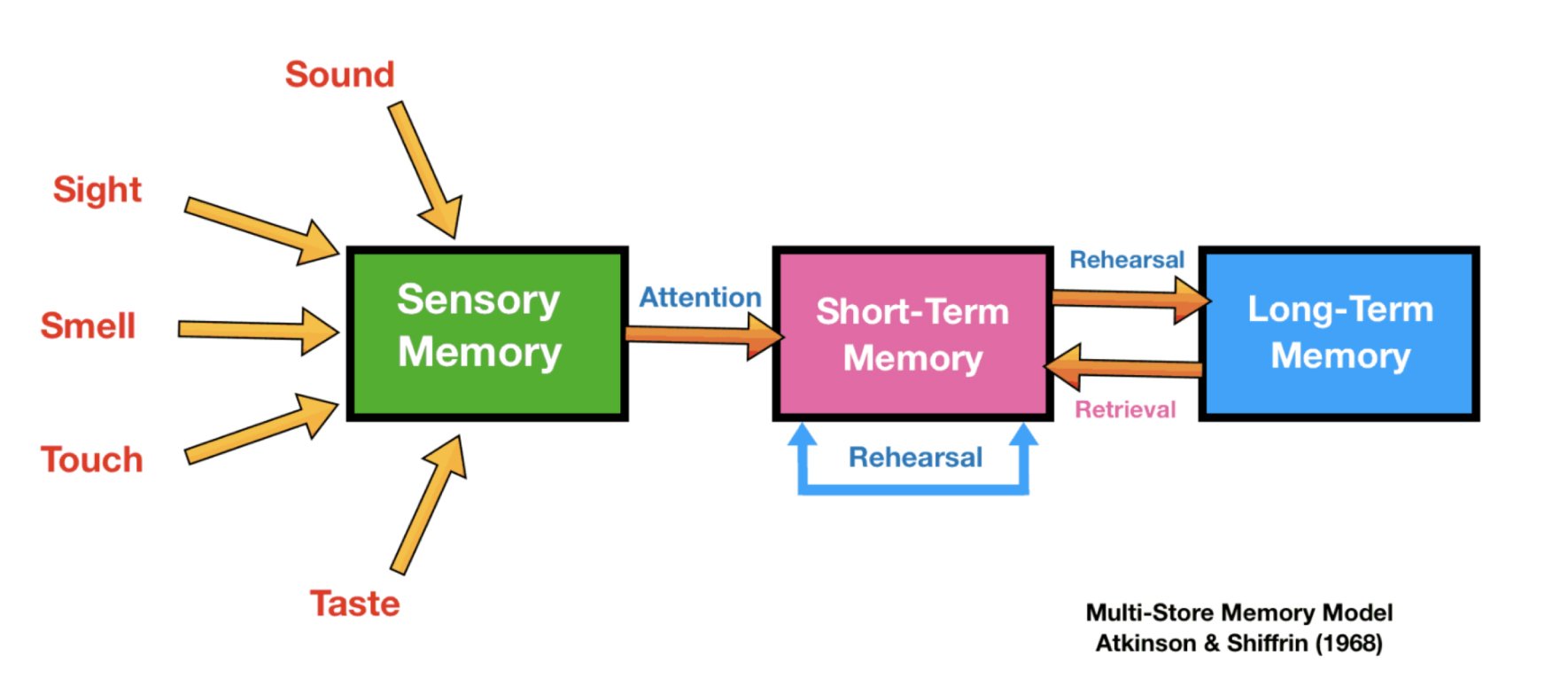
Sensory memory is the information you get from your sense, your eyes, and ears. When attention is paid to something in the environment, it is then converted to short-term memory.
Information from short-term memory is transferred to long-term memory only if that information is rehearsed (i.e., repeated).
Maintenance rehearsal is repetition that keeps information in STM, but eventually, such repetition will create an LTM.
If maintenance rehearsal (repetition) does not occur, then information is forgotten and lost from short-term memory through the processes of displacement or decay.
Each store has its own characteristics in terms of encoding, capacity, and duration.
- Encoding is the way information is changed so that it can be stored in memory. There are three main ways in which information can be encoded (changed): 1. visual (picture), 2. acoustic (sound), and 3. semantic (meaning).
- Capacity concerns how much information can be stored.
- Duration refers to the period of time information can last in-memory stores.
Sensory register
- Duration: ¼ to ½ second
- Capacity: all sensory experience (v. larger capacity)
- Encoding: sense specific (e.g., different stores for each sense)
Short Term Memory
- Duration: 0-18 seconds
- Capacity: 7 +/- 2 items
- Encoding: mainly acoustic
Long Term Memory
- Duration: Unlimited
- Capacity: Unlimited
- Encoding: Mainly semantic (but can be visual and acoustic)
AO2 Scenario Question
The multi-store model of memory has been criticized in many ways. The following example illustrates a possible criticism.
Some students read through their revision notes lots of times before an examination but still, find it difficult to remember the information. However, the same students can remember the information in a celebrity magazine, even though they read it only once.
Explain why this can be used as a criticism of the multi-store model of memory.
(4 marks)
Answer
“The MSM states that depth of memory trace in LTM is simply a result of the amount of rehearsal that takes place.
The MSM can be criticized for failing to account for how different types of material can result in different depth memory traces even though they’ve both been rehearsed for a similar amount of time.
For example, people may recall information they are interested in (e.g., information in celebrity magazines) more than the material they are not interested in (e.g., revision notes) despite the fact that they have both been rehearsed for a similar amount of time.
Therefore, the MSM’s view of long-term memory can be criticized for failing to take into account that material we may pay more attention to or is more meaningful/interesting to us may cause a deeper memory trace which is recalled more easily.”
AO3
One strength of the multistore model is that it gives us a good understanding of the structure and process of the STM. This is good because this allows researchers to expand on this model. This means researchers can do experiments to improve on this model and make it more valid, and they can prove what the stores actually do.
The model is supported by studies of amnesiacs: For example the patient H.M. case study. HM is still alive but has marked problems in long-term memory after brain surgery.
He has remembered little of personal (death of mother and father) or public events (Watergate, Vietnam War) that have occurred over the last 45 years. However, his short-term memory remains intact.
It has now become apparent that both short-term and long-term memory is more complicated than previously thought. For example, the Working Model of Memory proposed by Baddeley and Hitch (1974) showed that short-term memory is more than just one simple unitary store and comprises different components (e.g., central executive, Visuospatial, etc.).
The model suggests rehearsal helps to transfer information into LTM, but this is not essential. Why are we able to recall information which we did not rehearse (e.g., swimming) yet unable to recall information which we have rehearsed (e.g., reading your notes while revising)?
Therefore, the role of rehearsal as a means of transferring from STM to LTM is much less important than Atkinson and Shiffrin (1968) claimed in their model.
Research Study for both STM & LTM
AO1 or AO3
Research studies can either be knowledge or evaluation:
- If you refer to the procedures and findings of a study, this shows knowledge and understanding (AO1).
- If you comment on what the studies show and what it supports and challenges the theory in question, this shows evaluation (AO3).
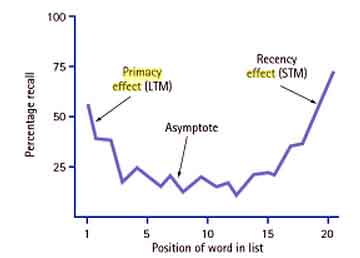
Glanzer and Cunitz showed that when participants are presented with a list of words, they tend to remember the first few and last few words and are more likely to forget those in the middle of the list, i.e., the serial position effect.
This supports the existence of separate LTM and STM stores because they observed a primacy and recency effect.
Words early on in the list were put into long-term memory (primacy effect) because the person has time to rehearse the word, and words from the end went into short-term memory (recency effect).
Other compelling evidence to support this distinction between STM and LTM is the case of KF (Shallice & Warrington, 1970), who had been in a motorcycle crash where he had sustained brain damage. His LTM seemed to be unaffected, but he was only able to recall the last bit of information he had heard in his STM.
Types of Long-Term Memory
AO1
One of the earliest and most influential distinctions of long-term memory was proposed by Tulving (1972). He proposed a distinction between episodic, semantic, and procedural memory.
Procedural Memory
Procedural memory is a part of the implicit long-term memory responsible for knowing how to do things, i.e., a memory of motor skills. A part of long-term memory is responsible for knowing how to do things, i.e., the memory of motor skills. It does not involve conscious (i.e., it’s unconscious-automatic) thought and is not declarative.
For example, procedural memory would involve knowledge of how to ride a bicycle.
Semantic Memory
Episodic Memory
Episodic memory is a part of the long-term memory responsible for storing information about events (i.e., episodes) that we have experienced in our lives.
It involves conscious thought and is declarative. An example would be a memory of our 1st day at school.
Cohen and Squire (1980) drew a distinction between declarative knowledge and procedural knowledge. Procedural knowledge involves “knowing how” to do things. It included skills such as “knowing how” to play the piano, ride a bike, tie your shoes, and other motor skills.
It does not involve conscious thought (i.e., it’s unconscious-automatic). For example, we brush our teeth with little or no awareness of the skills involved.
Whereas declarative knowledge involves “knowing that”; for example, London is the capital of England, zebras are animals, your mum’s birthday, etc. Recalling information from declarative memory involves some degree of conscious effort – information is consciously brought to mind and “declared.”
The knowledge that we hold in semantic and episodic memories focuses on “knowing that” something is the case (i.e., declarative). For example, we might have a semantic memory for knowing that Paris is the capital of France, and we might have an episodic memory for knowing that we caught the bus to college today.
AO3
Evidence for the distinction between declarative and procedural memory has come from research on patients with amnesia. Typically, amnesic patients have great difficulty in retaining episodic and semantic information following the onset of amnesia.
Their memory for events and knowledge acquired before the onset of the condition tends to remain intact, but they can’t store new episodic or semantic memories. In other words, it appears that their ability to retain declarative information is impaired.
However, their procedural memory appears to be largely unaffected. They can recall skills they have already learned (e.g., riding a bike) and acquire new skills (e.g., learning to drive).
Working Memory Model
AO1
The working memory model (Baddeley and Hitch, 1974) replaced the idea of a unitary STM. It suggests a system involving active processing and short-term storage of information.
Key features include the central executive, the phonological loop, and the visuospatial sketchpad.
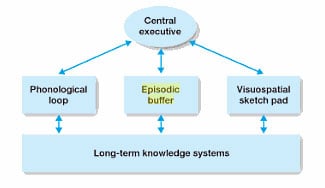
The central executive has a supervisory function and acts as a filter, determining which information is attended to.
It can process information in all sensory forms, direct information to other slave systems, and collects responses. It has limited capacity and deals with only one piece of information at a time.
One of the slave systems is the phonological loop which is a temporary storage system for holding auditory information in a speech-based form.
It has two parts: (1) the phonological store (inner ear), which stores words you hear; and (2) the articulatory process (inner voice), which allows maintenance rehearsal (repeating sounds or words to keep them in working memory while they are needed). The phonological loop plays a key role in the development of reading.
The second slave system is the Visuospatial sketchpad (VSS). The VSS is a temporary memory system for holding visual and spatial information. It has two parts: (1) the visual cache (which stores visual data about form and color) and (2) the inner scribe (which records the arrangement of objects in the visual field and rehearses and transfers information in the visual cache to the central executive).
The third slave system is the episodic buffer which acts as a “backup” (temporary) store for information that communicates with both long-term memory and the slave system components of working memory. One of its important functions is to recall material from LTM and integrate it into STM when working memory requires it.
AO2 Scenario Question
Bryan has been driving for five years. Whilst driving, Bryan can hold conversations or listen to music with little difficulty.
Bob has had four driving lessons. Driving requires so much of Bob’s concentration that, during lessons, he often misses what his driving instructor is telling him. With reference to features of the working memory model, explain the different experiences of Bryan and Bob. (4 marks)
A tricky question – the answer lies in Bryan being able to divide the different components of his STM because he is experienced at driving and doesn’t need to devote all his attention to the task of driving (controlled by the visuospatial sketchpad).
Answer
“Because Bryan has been driving for five years it is an ‘automated’ task for him; it makes fewer attentional demands on his central executive, so he is free to perform other tasks (such as talking or listening to music) and thus is able to divide resources between his visuospatial sketch pad (driving) and phonological loop (talking and listening to music).
As Bob is inexperienced at driving, this is not the case for him – his central executive requires all of his attentional capacity for driving and thus cannot divide resources effectively between components of working memory.”
AO3
Working memory is supported by dual-task studies. It is easier to do two tasks at the same time if they use different processing systems (verbal and visual) than if they use the same slave system.
For example, participants would find it hard to do two visual tasks at the same time because they would be competing for the same limited resources of the visuospatial sketchpad. However, a visual task and a verbal task would use different components and so could be performed with minimum errors.
The KF Case Study supports the Working Memory Model. KF suffered brain damage from a motorcycle accident that damaged his short-term memory. KF’s impairment was mainly for verbal information – his memory for visual information was largely unaffected.
This shows that there are separate STM components for visual information (VSS) and verbal information (phonological loop). However, evidence from brain-damaged patients may not be reliable because it concerns unique cases with patients who have had traumatic experiences.
One limitation is the fact that little is known about how the central executive works. It is an important part of the model, but its exact role is unclear.
Another limitation is that the model does not explain the link between working memory and LTM.
Research Study for WM
AO1 or AO3
Research studies can either be knowledge or evaluation:
- If you refer to the procedures and findings of a study, this shows knowledge and understanding.
- If you comment on what the studies show and what it supports and challenges the theory in question, this shows evaluation.
Baddeley and Hitch conducted an experiment in which participants were asked to perform two tasks at the same time (dual task technique). A digit span task required them to repeat a list of numbers, and a verbal reasoning task which required them to answer true or false to various questions (e.g., B is followed by A?).
Results: As the number of digits increased in the digit span tasks, participants took longer to answer the reasoning questions, but not much longer – only fractions of a second. And they didn’t make any more errors in the verbal reasoning tasks as the number of digits increased.
Conclusion: The verbal reasoning task made use of the central executive, and the digit span task made use of the phonological loop.
Explanations for Forgetting
Interference
AO1
Interference is an explanation for forgetting from long-term memory – two sets of information become confused.
- Proactive interference (pro=forward) is where old learning prevents the recall of more recent information. When what we already know interferes with what we are currently learning – where old memories disrupt new memories.
- Retroactive interference (retro=backward) is where new learning prevents the recall of previously learned information. In other words, later learning interferes with earlier learning – where new memories disrupt old memories.
Proactive and retroactive Interference is thought to be more likely to occur where the memories are similar, for example: confusing old and new telephone numbers. Chandler (1989) stated that students who study similar subjects at the same time often experience interference. French and Spanish are similar types of material which makes interference more likely.
AO3
Semantic memory is more resistant to interference than other types of memory.
Postman (1960) provides evidence to support the interference theory of forgetting. A lab experiment was used, and participants were split into two groups. Both groups had to remember a list of paired words – e.g., cat – tree, jelly – moss, book – tractor.
The experimental group also had to learn another list of words where the second paired word is different – e.g., cat – glass, jelly- time, book – revolver. The control group was not given the second list.
All participants were asked to recall the words on the first list. The recall of the control group was more accurate than that of the experimental group. This suggests that learning items in the second list interfered with participants’ ability to recall the list. This is an example of retroactive interference.
Although proactive and retroactive interference is reliable and robust effects, there are a number of problems with interference theory as an explanation for forgetting.
First, interference theory tells us little about the cognitive processes involved in forgetting. Secondly, the majority of research into the role of interference in forgetting has been carried out in a laboratory using lists of words, a situation that is likely to occur fairly infrequently in everyday life (i.e., low ecological validity). As a result, it may not be possible to generalize from the findings.
Baddeley states that the tasks given to subjects are too close to each other and, in real life; these kinds of events are more spaced out. Nevertheless, recent research has attempted to address this by investigating “real-life” events and has provided support for interference theory. However, there is no doubt that interference plays a role in forgetting, but how much forgetting can be attributed to interference remains unclear.
Retrieval failure
AO1
Retrieval failure is where information is available in long-term memory but cannot be recalled because of the absence of appropriate cues.
When we store a new memory, we also store information about the situation and these are known as retrieval cues. When we come into the same situation again, these retrieval cues can trigger the memory of the situation.
Types of cues that have been studied by psychologists include context, state, and organization.
- Context – external cues in the environment, e.g., smell, place, etc. Evidence indicates that retrieval is more likely when the context at encoding matches the context at retrieval.
- State – bodily cues inside of us, e.g., physical, emotional, mood, drunk, etc. The basic idea behind state-dependent retrieval is that memory will be best when a person’s physical or psychological state is similar to encoding and retrieval.
For example, if someone tells you a joke on Saturday night after a few drinks, you”ll be more likely to remember it when you”re in a similar state – at a later date after a few more drinks. Stone cold sober on Monday morning, you”ll be more likely to forget the joke.
- Organization – Recall is improved if the organization gives a structure that provides triggers, e.g., categories.
According to retrieval-failure theory, forgetting occurs when information is available in LTM but is not accessible. Accessibility depends in large part on retrieval cues.
Forgetting is greatest when context and state are very different at encoding and retrieval. In this situation, retrieval cues are absent, and the likely result is cue-dependent forgetting.
Evaluation (AO3)
People tend to remember material better when there is a match between their mood at learning and at retrieval. The effects are stronger when the participants are in a positive mood than when they are in a negative mood. They are also greater when people try to remember events having personal relevance.
A number of experiments have indicated the importance of context-based (i.e., external) cues for retrieval. An interesting experiment conducted by Baddeley indicates the importance of context setting for retrieval.
Baddeley (1975) asked deep-sea divers to memorize a list of words. One group did this on the beach, and the other group underwater. When they were asked to remember the words, half of the beach learners remained on the beach, and the rest had to recall underwater.
Half of the underwater group remained there, and the others had to recall on the beach. The results show that those who had recalled in the same environment (i.e., context) and who had learned recalled 40% more words than those recalling in a different environment. This suggests that the retrieval of information is improved if it occurs in the context in which it was learned.
A study by Goodwin investigated the effect of alcohol on state-dependent (internal) retrieval. They found that when people encoded information when drunk, they were more likely to recall it in the same state.
For example, when they hid money and alcohol when drunk, they were unlikely to find them when sober. However, when they were drunk again, they often discovered the hiding place. Other studies found similar state-dependent effects when participants were given drugs such as marijuana.
The ecological validity of these experiments can be questioned, but their findings are supported by evidence from outside the laboratory. For example, many people say they can’t remember much about their childhood or their school days. But returning to the house in which they spent their childhood or attending a school reunion often provides retrieval cues that trigger a flood of memories.
Eyewitness Testimony
Misleading Information
AO1
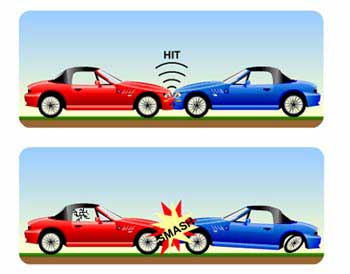
Loftus and Palmer investigated how misleading information could distort eyewitness testimony accounts.
Procedure: Forty-five American students formed an opportunity sample. This was a laboratory experiment with five conditions, only one of which was experienced by each participant (an independent measures experimental design ).
Participants were shown slides of a car accident involving a number of cars and asked to describe what had happened as if they were eyewitnesses. They were then asked specific questions, including the question, “About how fast were the cars going when they (hit/smashed/collided/bumped/contacted ) each other?”
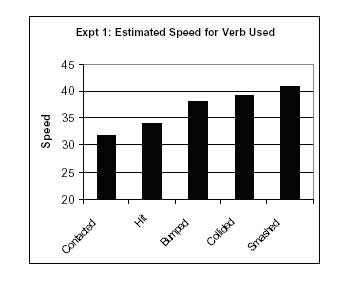
Findings: The estimated speed was affected by the verb used. The verb implied information about the speed, which systematically affected the participants’ memory of the accident.
Participants who were asked the “smashed” question thought the cars were going faster than those who were asked the “hit” question. The participants in the “smashed” condition reported the highest speeds, followed by “collided,” “bumped,” “hit,” and “contacted” in descending order.
AO3
The research lacks mundane realism, as the video clip does not have the same emotional impact as witnessing a real-life accident, and so the research lacks ecological validity.
A further problem with the study was the use of students as participants. Students are not representative of the general population in a number of ways. Importantly they may be less experienced drivers and, therefore, less confident in their ability to estimate speeds. This may have influenced them to be more swayed by the verb in the question.
A strength of the study is it’s easy to replicate (i.e., copy). This is because the method was a laboratory experiment that followed a standardized procedure.
Anxiety
AO1
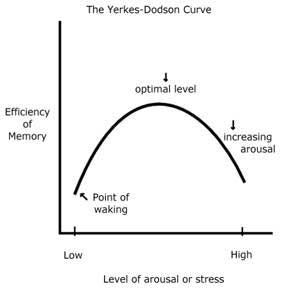
The Yerkes-Dodson effect states that when anxiety is at low and high levels, EWT is less accurate than if anxiety is at a medium level. Recall improves as anxiety increases up to an optimal point and then declines.
When we are in a state of anxiety, we tend to focus on whatever is making us feel anxious or fearful, and we exclude other information about the situation. If a weapon is used to threaten a victim, their attention is likely to focus on it. Consequently, their recall of other information is likely to be poor.
Clifford and Scott (1978) found that people who saw a film of a violent attack remembered fewer of the 40 items of information about the event than a control group who saw a less stressful version. As witnessing a real crime is probably more stressful than taking part in an experiment, memory accuracy may well be even more affected in real life.
However, a study by Yuille and Cutshall (1986) contradicts the importance of stress in influencing eyewitness memory. Twenty-one witnesses observed a shooting incident in Canada outside a gun shop in which one person was killed and a 2nd seriously wounded. The incident took place on a major thoroughfare in the mid-afternoon.
All of the witnesses were interviewed by the investigating police, and 13 witnesses (aged 15-32 yrs) agreed to a research interview 4-5 months after the event. The witnesses were also asked to rate how stressed they had felt at the time of the incident using a 7-point scale. The eyewitness accounts provided in both the police and research interviews were analyzed and compared.
The results of the study showed the witnesses were highly accurate in their accounts, and there was little change in the amount or accuracy of recall after five months. The study also showed that stress levels did not have an effect on memory, contrary to lab findings.
All participants showed high levels of accuracy, indicating that stress had little effect on accuracy. However, very high anxiety was linked to better accuracy. Participants who reported the highest levels of stress were most accurate (about 88% accurate compared to 75% for the less-stressed group).
AO3
One strength of this study is that it had high ecological validity compared with lab studies which tend to control variables and use student populations as research participants.
One weakness of this study was that there was an extraneous variable. The witnesses who experienced the highest levels of stress were actually closer to the event (the shooting), and this may have helped with the accuracy of their memory recall.
Reduced accuracy of information may be due to surprise rather than anxiety – Pickel found that identification was least accurate in high surprise conditions rather than high threat conditions – The weapon focus effect may be related to surprise rather than anxiety; therefore, research may lack internal validity.
Real-world application: We can apply the Yerkes-Dodson effect to predict that stressful incidents will lead to witnesses having relatively inaccurate memories as their anxiety levels would be above the optimum – We can avoid an over-reliance on eyewitness testimony that may have been impacted by anxiety.
The Cognitive Interview
The cognitive interview is a police technique for interviewing witnesses to a crime which encourages them to recreate the original context in order to increase the accessibility of stored information.
AO1
The cognitive interview involves a number of techniques:
Context Reinstatement
Trying to mentally recreate an image of the situation, including details of the environment, such as the weather conditions, and the individual’s emotional state, including their feelings at the time of the incident. This makes memories accessible and provides emotional and contextual cues.
Recall from a Changed Perspective
Recall in Reverse Order
Report Everything
The interviewer encourages the witness to report all details about the event, even though these details may seem unimportant. Memories are interconnected so that recollection of one item may then cue a whole lot of other memories.
The Enhanced Cognitive Interview
The main additional features are:-
- Encourage the witness to relax and speak slowly.
- Offer comments to help clarify witness statements.
- Adapt questions to suit the understanding of individual witnesses.
AO3
One limitation is the cognitive interview is that it’s time-consuming to conduct and takes much longer than a standard police interview. It is also time-consuming to train police officers to use this method. This means that it is unlikely that the “proper” version of the cognitive interview is used.
Another limitation is that some elements of the cognitive interview may be more valuable than others. For example, research has shown that using a combination of “report everything” and “context reinstatement” produced better recall than any of the conditions individually.
A final criticism is that police personnel have to be trained, and this can be expensive and time-consuming.
Geiselman (1985) set out to investigate the effectiveness of the cognitive interview. Participants viewed a film of a violent crime and, after 48 hours, were interviewed by a policeman using one of three methods: the cognitive interview, a standard interview used by the Los Angeles Police, or an interview using hypnosis.
The number of facts accurately recalled and the number of errors made was recorded. The average number of correctly recalled facts for the cognitive interview was 41.2. For hypnosis, it was 38.0, and for the standard interview, it was 29.4.

